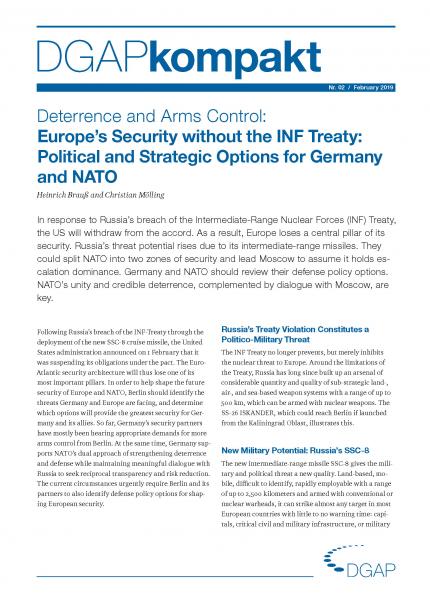Following Russia’s breach of the INF-Treaty through the deployment of the new SSC-8 cruise missile, the United States administration announced on 1 February that it was suspending its obligations under the pact. The Euro-Atlantic security architecture will thus lose one of its most important pillars. In order to help shape the future security of Europe and NATO, Berlin should identify the threats Germany and Europe are facing, and determine which options will provide the greatest security for Germany and its allies. So far, Germany’s security partners have mostly been hearing appropriate demands for more
arms control from Berlin. At the same time, Germany supports NATO’s dual approach of strengthening deterrence and defense while maintaining meaningful dialogue with Russia to seek reciprocal transparency and risk reduction. The current circumstances urgently require Berlin and its partners to also identify defense policy options for shaping European security.
Russia’s Treaty Violation Constitutes a Politico-Military Threat
The INF Treaty no longer prevents, but merely inhibits the nuclear threat to Europe. Around the limitations of the Treaty, Russia has long since built up an arsenal of considerable quantity and quality of sub-strategic land-, air-, and sea-based weapon systems with a range of up to 500 km, which can be armed with nuclear weapons. The SS-26 ISKANDER, which could reach Berlin if launched from the Kaliningrad Oblast, illustrates this.
New Military Potential: Russia’s SSC-8
The new intermediate-range missile SSC-8 gives the military and political threat a new quality. Land-based, mobile, difficult to identify, rapidly employable with a range of up to 2,500 kilometers and armed with conventional or nuclear warheads, it can strike almost any target in most European countries with little to no warning time: capitals, critical civil and military infrastructure, or military headquarters. This potential could therefore considerably restrict NATO’s operational freedom of action in a conflict. For instance, it could massively affect the reinforcement of allies at risk in northern, eastern and south-eastern Europe. As a result, NATO’s general ability to defend itself could be seriously compromised.
Perceived Escalation Dominance: The Strategic Effect of the SSC-8
In light of the above, the political-strategic purpose of the new SSC-8 is to paralyze the European allies’ political decision-making ability as well as their resolve and willingness to defend themselves and their allies in case of a crisis and military conflict. This function of the missile, therefore, is effective already in peacetime. It can influence the political assessments of Western governments, parliaments, the media and populations: The mere threat of using the missile is intended to cause surprise, fear and doubt among these actors. If the menace toward one or more NATO members were to prove successful and lead to different security perceptions among allies, Moscow would affect NATO’s strategic core: the solidarity and unity of the Alliance. The potential to weaken NATO could prompt Moscow to believe that Russia has achieved missile and nuclear superiority over Europe and that, as a result, it has assumed the so-called escalation dominance. The Russian leaders could conclude that they could afford to take the risk of deliberately escalating a military conflict in the belief that they would be able to manage it to their own advantage. Increased confidence in its military strength could embolden Moskow’s willingness to use aggression, nuclear blackmailing or the threat of escalation to enforce its interests and boost its political and military risk-taking. Such a perception would increase Moscow’s assertiveness not only in times of crises, but even in peacetime.
Political Implications: Two Zones of Security within NATO
Another political effect of the SSC-8 is the division of NATO into two zones of security: The missiles can reach almost any target in Europe, but not the US. This factor carries the risk of decoupling Europe’s security from that of North America. Precisely this has always been one of the main geostrategic goals of the Russian leadership, and one of the greatest concerns of the European allies. In a crisis, Moscow could attempt to dissuade Washington from intervening, in order to prevent a nuclear counter- threat by the US and confine the conflict to Europe.
Russia’s Conflict Strategy: Hybrid Warfare and Fait Accompli
Moscow aims to achieve its geostrategic goals, both in peacetime and in a crisis, while remaining below the threshold of a direct military confrontation with the West, especially the US. A range of different measures – known as “hybrid warfare” in NATO and “new generation warfare” in Moscow – is used in order to destabilize Western democracies. It includes disinformation campaigns, cyber-attacks, subversion, influencing democratic elections, as well as economic and diplomatic pressure, large- scale military exercises on NATO’s borders at short or no notice, and a continuing military build-up. In the event of a conflict, Russia would probably seek to launch a short, rapid military attack to quickly create a military fait accompli with conventional armed forces. Moscow could then underpin and secure its military gains by means of a nuclear threat against NATO-Europe, for example, by means of the SSC-8. In such a scenario, Moscow would send a signal to Washington that it was not threatening the United States directly, but seeking a bilateral agreement over the heads of the Europeans.
Options for Action: Deterrence and Arms Control
Germany and its NATO allies should now consider how to respond to the threats described above, and what options are viable to counter the intended political and military effect of the new Russian arsenal.
The ideal solution would be for Moscow to return to treaty compliance. According to the terms of the INF Treaty, the American withdrawal does not take effect until six months after notice has been given. This time must be used at political level. In this respect, the arms control conference spearheaded by German Foreign Minister Heiko Maas, which is scheduled to take place in Berlin in March, offers a solid opportunity.
However, it is unrealistic to assume that Moscow would return to compliance unless Germany and NATO underpin the seriousness of their political negotiation goals and intentions. They should therefore credibly announce that the allies are prepared to take appropriate countermeasures to neutralize the political and strategic effects of the Russian threat. For this reason, it is crucial even now to assess the options which could influence Moscow’s political and strategic cost-benefit calculations.
It would therefore be a mistake if Brussels or Berlin politically committed itself to certain measures and deliberately excluded others. Relying on diplomatic efforts alone and ruling out specific military countermeasures from the outset would weaken Europe’s defense and increase Russia’s options.
Preserving NATO Unity and Ensuring Deterrence
NATO allies should prioritize two political objectives in the negotiations: First, they have to preserve the unity of the Alliance. And second, if Moscow’s cooperation is not forthcoming, the credibility of NATO’s deterrence posture has to be maintained in its entirety. Given that the deployment of the SSC-8 is intended to undermine the US guarantee of extended nuclear deterrence, Germany and NATO should only consider those options that preserve the indivisibility of the security of the entire North American and European territory.
First developments are already emerging: As the SSC-8 deployment must be seen in the context of Russia’s broader conflict strategy, NATO should respond with a package of measures and options. For deterrence to be credible, it should rely on an array of options, of which those are selected and utilized which would most likely deter the Russian leadership from launching an attack or threatening allies with it in a crisis. In order to deny Moscow the option of a military fait accompli, NATO also has to substantially strenghen its conventional – i.e. non-nuclear – collective defense capability. Allies have already taken important decisions and implemented far-reaching measures to this end. One example is the rotational forward presence of limited multinational combat forces in Poland and the Baltic states. They signal that even a limited Russian incursion into one or several of these countries would be immediately countered by allied military forces and engage NATO as a whole. What matters now, is to ensure that NATO is able to rapidly reinforce allies that are located at the periphery of the Alliance’s territory with rapidly available, modern, fully equipped land, maritime and air forces. An integral part of this is that NATO and its allies, including Germany, ensure an effective air and missile Europe. Therefore, the effectiveness of air and missile defense capabilities must urgently be reviewed and, if necessary, adjusted.
Washington is currently planning to counter the regional nuclear threat which Russia has focused on Europe by means of a limited number of sea-launched ballistic missiles (SLBM) with low-yield nuclear warheads, and, in the medium term, with a sea-launched nuclear cruise missile (SLCM). While, according to latest reports, the US has started producing the SLBM, the SLCM would still have to be developed. It is, therefore, not a near-term option.
A conventional option would be to develop and deploy land-based, high-precision and high-impact conventional intermediate-range missiles in Europe that could threaten Moscow’s command facilities and limit Russia’s military ability to act. However, the development of land-based intermediate-range nuclear weapons and their deployment in Europe should not be ruled out from the outset. NATO allies will also have to consider whether to include cyber operations in the package of options if these could be employed in a targeted and phased manner.
NATO as a Nuclear Alliance: Effective Strategic Communication
Moreover, Alliance-wide effective strategic communication is crucial. NATO should always clearly signal to the Russian leadership that it is and will remain a nuclear alliance. Any employment of nuclear weapons against the Alliance would fundamentally alter the nature of a conflict. It would impose costs on Russia that would be unacceptable and far outweigh the benefits that Moscow could hope to achieve.
Arriving at a viable set of responses requires in-depth analysis and an open-ended examination by both NATO and allied capitals. National predeterminations of specific options would undermine security rather than strengthen it. Nor would they be conducive to the unity of both the Alliance and Europe.
Finally, the allies should explain the security situation in Europe more clearly in their own parliaments and to their respective populations, and lay out their security policy considerations and decisions. This includes explaining how deterrence and dialogue jointly contribute to Europe’s security.



